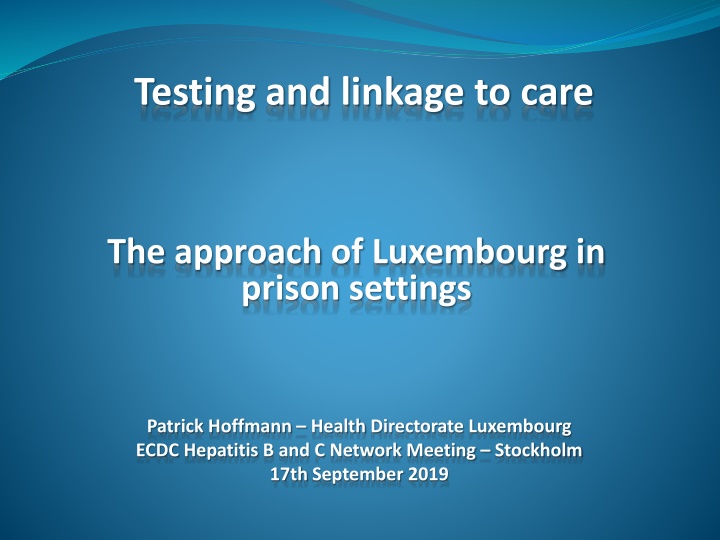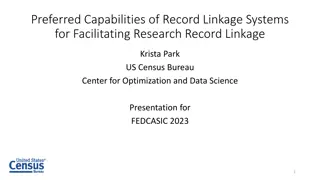Luxembourg's Approach to Testing and Linkage to Care in Prison Settings
Luxembourg's approach to testing and linkage to care in prison settings is comprehensive and involves thorough medical services, including somatic medicine and psychiatric care. The system ensures that every inmate is seen by a medical doctor within 24 hours, undergoes blood tests, receives appropriate treatment and prevention measures, harm reduction strategies, and vaccination programs if needed. Collaboration with NGOs enhances the effectiveness of the approach.
Download Presentation

Please find below an Image/Link to download the presentation.
The content on the website is provided AS IS for your information and personal use only. It may not be sold, licensed, or shared on other websites without obtaining consent from the author.If you encounter any issues during the download, it is possible that the publisher has removed the file from their server.
You are allowed to download the files provided on this website for personal or commercial use, subject to the condition that they are used lawfully. All files are the property of their respective owners.
The content on the website is provided AS IS for your information and personal use only. It may not be sold, licensed, or shared on other websites without obtaining consent from the author.
E N D
Presentation Transcript
Testing and linkage to care The approach of Luxembourg in prison settings Patrick Hoffmann Health Directorate Luxembourg ECDC Hepatitis B and C Network Meeting Stockholm 17th September 2019
To put you into the right context Twoprisons in Luxembourg Bildergebnis f r map of luxembourg One closed setting in Schrassig 615 inmates for 600 places (48% prisoners / 52% pretrial detainees) 25% LU-citizens vs 75% non LU-citizens 94% men vs 6% women One half open setting in Givenich A prison without walls and fences, but nevertheless a prison Normal regime (working and sleeping in prison) and half free regime (working outside for privateemployers and sleeping in prison) 74 inmates for 99 places, only prisoners, no ptd Turnover: approx. 1000 / y Bildergebnis f r prison schrassig Bildergebnis f r prison givenich
The medical service in Luxembourg prisons Somatic medecine Service of Centre Hospitalier de Luxembourg 3 part time MD 1 resident 1 assistant Different specialists coming into prison 20 nurses 1 head nurse 24/7 3 surgeries 1 pharmacist 4 preparators different facilities (X-Ray, dentist, ophtalmologist, gynaecologist Ultrasound, Fibroscan Approx 13000 consultations / year Psychiatric service Service of Neuropsychiatrical hospital in Ettelbruck Ambulatory care and intensive care unit Different specialists coming into prison Detect, treatand prevent mental disorders Pluriprofessional approach (MD, nurses, social assistant, ergotherapist) 7/7 6am to 9.30pm
Our approach Test Prison law: every inmate has to be seen by a MD within 24 hours afterentry in prison Complete history Blood test proposal (HIV, HAV, HBV, HCV, Syphilis, IGRA): take-up > 95% Chest X-Ray ECG Treat Prevent Different harm reduction measures in place OST Vaccination program Needle and syringe exchange program Condom provision Safe tattoo project Information sessions and educational work Working togetherwith NGO s There should be a comprehensive package in place
The system actually in place MD visit Testing Coming into prison First 24 hours Max. first 72 hours Information by MD max 48 hours after results Visit by ID specialist Results Within 2 weeks after information Max. 48 hours after testing Vaccination if needed (HAV / HBV) If treatment Based on EASL guidelines All DAA s are available DOT is possible All costs funded by Ministry of Justice Ultrasound Fibroscan (nurses) Treatment if necessary
Linkage to care All patients with an infectious disease are seen by an infectious disease specialist within 2 weeks afterdiagnose announcement If treatment needed, it is accessible At release, inmates get all information (blood test results, treatments, resultsof Ultrasound and Fibroscan, addressof hospital and NGO s, aso ) If the inmates asks, an appointment can be taken with ID specialist in hospital after release.
COMATEP Consultation infirmi re pour maladies transmissibles en prison Nurse practicioner coordinated clinic for infectious diseases in prisons Project started in 2009 High numberof inmates due to drug-related offences High prevalence of HIV, viral hepatitisand other infectious complications related to illicit drug use Required a standardised approach Work of the nurse in charge Verification if every inmate gota blood analysis Registration for MD consultation if seropositivity Organization of the ID specialist consultation Preparation of request for blood analysis (follow-up) Realization of Fibroscan Realization of questionnaire for the HCV study in prison Counselling Organization of specific appointments (NGO s, ) Preparation of the release (medical reports, treatment, blood analysis reports) Informational sessions for prison employees Today, two full time nurses are leading COMATEP
Some data From 2013 up to 2018 4218 screening tests 666 persons were HCV Ab+ (15,78%) 140 persons were HBV Ag+ (3,32%) 160 ID specialist consultations for 2186 patients 1100 Fibroscan / 769 ultrasound examinations 3828 HAV / HBV vaccinations have been provided 33% of the inmates were not aware of their seropositivity
HCV treatments Before the arrival of DAA s, standard therapy was a combination of pegINF and RBV * 209 inmates were treated with 136 obtaining SVR after a median of 4.4 years of follow-up (65.1%) ** 32 patients got reinfected after prison release ** Since then the link to OST prescribers and other facilities in the field outside prison was strengthen ** * V.Arendt, P.Hoffmann et al., European Conference on Hepatitis C and drug use, Berlin, 2014 ** C.Devaux et al., High recurrence rate of Hepatits C infection after treatment in prison inmates in Luxembourg, 2017
HCV treatments 2* Since arrival of the DAA s, 90 inmates have been treated - 92,3% completed therapy in prison - 96,4% of these had an undetectable VL at end of the treatment - 100% of those who performed a VL at week 12 after treatment achieved a sustained virological response - 29 persons were lost to follow up, in 18 of them a detectable VL was available at a later date 100 90 83 90 80 80 70 61 61 60 50 40 30 18 20 10 0 * C. Devaux, V. Arendt, P.Hoffmann et al, Good practices on implementation of the Action Plan for the Health Sector Response to Viral Hepatitis in the WHO European Region, 2019
Conclusions A stay in prison is an effective opportunity to test and treat a group of patients or PWID, who otherwise have very limited access to testing, to therapy and education for prevention and control of infectious diseases Combined prevention should include harm reduction measures offering a comprehensive package (with OST, PNSP, condom provision, vaccination program and education a.o.) Working with extra-muros facilities (NGO s, drug services, HR services) is a must (Build a bridge !)
Next steps Sustainability of the practice new prison to come (eventually other health care providers) The programs should be living Evaluate, improve, report Reflexions on new projects Save piercing, take home naloxone, diamorphine
Do not forget It s not the place, it s the people !
Acknowledgments Dr Carole Devaux, Department of Infection and Immunity, Luxembourg Institute of Health Dr Vic Arendt, ID specialist, Centre Hospitalier de Luxembourg Medical prison service, Centre Hospitalier de Luxembourg Thank you for your attention patrick.hoffmann@ms.etat.lu























